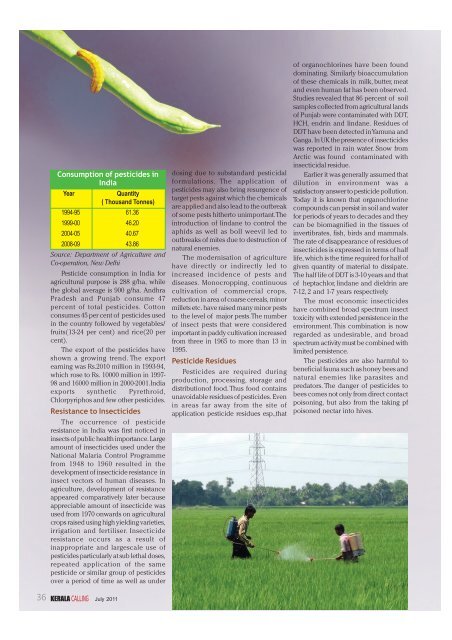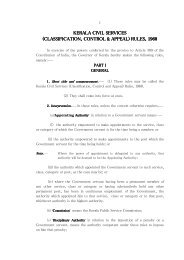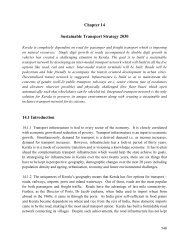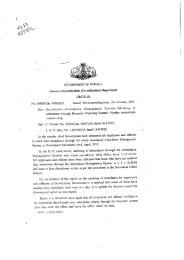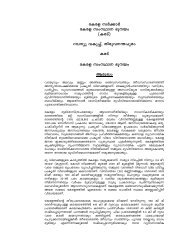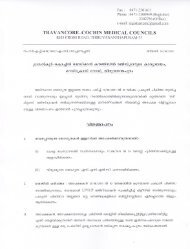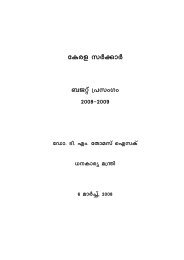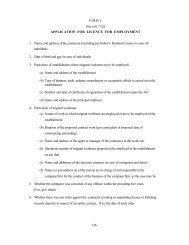est Control - Government of Kerala
est Control - Government of Kerala
est Control - Government of Kerala
You also want an ePaper? Increase the reach of your titles
YUMPU automatically turns print PDFs into web optimized ePapers that Google loves.
Consumption <strong>of</strong> p<strong>est</strong>icides in<br />
India<br />
Year Quantity<br />
( Thousand Tonnes)<br />
1994-95 61.36<br />
1999-00 46.20<br />
2004-05 40.67<br />
2008-09 43.86<br />
Source: Department <strong>of</strong> Agriculture and<br />
Co-operation, New Delhi<br />
P<strong>est</strong>icide consumption in India for<br />
agricultural purpose is 288 g/ha, while<br />
the global average is 900 g/ha. Andhra<br />
Pradesh and Punjab consume 47<br />
percent <strong>of</strong> total p<strong>est</strong>icides. Cotton<br />
consumes 45 per cent <strong>of</strong> p<strong>est</strong>icides used<br />
in the country followed by vegetables/<br />
fruits(13-24 per cent) and rice(20 per<br />
cent).<br />
The export <strong>of</strong> the p<strong>est</strong>icides have<br />
shown a growing trend. The export<br />
earning was Rs.2010 million in 1993-94,<br />
which rose to Rs. 10000 million in 1997-<br />
98 and 16000 million in 2000-2001.India<br />
exports synthetic Pyrethroid,<br />
Chlorpyriphos and few other p<strong>est</strong>icides.<br />
Resistance to Insecticides<br />
The occurrence <strong>of</strong> p<strong>est</strong>icide<br />
resistance in India was first noticed in<br />
insects <strong>of</strong> public health importance. Large<br />
amount <strong>of</strong> insecticides used under the<br />
National Malaria <strong>Control</strong> Programme<br />
from 1948 to 1960 resulted in the<br />
development <strong>of</strong> insecticide resistance in<br />
insect vectors <strong>of</strong> human diseases. In<br />
agriculture, development <strong>of</strong> resistance<br />
appeared comparatively later because<br />
appreciable amount <strong>of</strong> insecticide was<br />
used from 1970 onwards on agricultural<br />
crops raised using high yielding varieties,<br />
irrigation and fertiliser. Insecticide<br />
resistance occurs as a result <strong>of</strong><br />
inappropriate and largescale use <strong>of</strong><br />
p<strong>est</strong>icides particularly at sub lethal doses,<br />
repeated application <strong>of</strong> the same<br />
p<strong>est</strong>icide or similar group <strong>of</strong> p<strong>est</strong>icides<br />
over a period <strong>of</strong> time as well as under<br />
36 KERALA CALLING July 2011<br />
dosing due to substandard p<strong>est</strong>icidal<br />
formulations. The application <strong>of</strong><br />
p<strong>est</strong>icides may also bring resurgence <strong>of</strong><br />
target p<strong>est</strong>s against which the chemicals<br />
are applied and also lead to the outbreak<br />
<strong>of</strong> some p<strong>est</strong>s hitherto unimportant. The<br />
introduction <strong>of</strong> lindane to control the<br />
aphids as well as boll weevil led to<br />
outbreaks <strong>of</strong> mites due to d<strong>est</strong>ruction <strong>of</strong><br />
natural enemies.<br />
The modernisation <strong>of</strong> agriculture<br />
have directly or indirectly led to<br />
increased incidence <strong>of</strong> p<strong>est</strong>s and<br />
diseases. Monocropping, continuous<br />
cultivation <strong>of</strong> commercial crops,<br />
reduction in area <strong>of</strong> coarse cereals, minor<br />
millets etc. have raised many minor p<strong>est</strong>s<br />
to the level <strong>of</strong> major p<strong>est</strong>s. The number<br />
<strong>of</strong> insect p<strong>est</strong>s that were considered<br />
important in paddy cultivation increased<br />
from three in 1965 to more than 13 in<br />
1995.<br />
P<strong>est</strong>icide Residues<br />
P<strong>est</strong>icides are required during<br />
production, processing, storage and<br />
distribution<strong>of</strong> food. Thus food contains<br />
unavoidable residues <strong>of</strong> p<strong>est</strong>icides. Even<br />
in areas far away from the site <strong>of</strong><br />
application p<strong>est</strong>icide residues esp.,that<br />
<strong>of</strong> organochlorines have been found<br />
dominating. Similarly bioaccumulation<br />
<strong>of</strong> these chemicals in milk, butter, meat<br />
and even human fat has been observed.<br />
Studies revealed that 86 percent <strong>of</strong> soil<br />
samples collected from agricultural lands<br />
<strong>of</strong> Punjab were contaminated with DDT,<br />
HCH, endrin and lindane. Residues <strong>of</strong><br />
DDT have been detected in Yamuna and<br />
Ganga. In UK the presence <strong>of</strong> insecticides<br />
was reported in rain water. Snow from<br />
Arctic was found contaminated with<br />
insecticidal residue.<br />
Earlier it was generally assumed that<br />
dilution in environment was a<br />
satisfactory answer to p<strong>est</strong>icide pollution.<br />
Today it is known that organochlorine<br />
compounds can persist in soil and water<br />
for periods <strong>of</strong> years to decades and they<br />
can be biomagnified in the tissues <strong>of</strong><br />
invertibrates, fish, birds and mammals.<br />
The rate <strong>of</strong> disappearance <strong>of</strong> residues <strong>of</strong><br />
insecticides is expressed in terms <strong>of</strong> half<br />
life, which is the time required for half <strong>of</strong><br />
given quantity <strong>of</strong> material to dissipate.<br />
The half life <strong>of</strong> DDT is 3-10 years and that<br />
<strong>of</strong> heptachlor, lindane and dieldrin are<br />
7-12, 2 and 1-7 years respectively.<br />
The most economic insecticides<br />
have combined broad spectrum insect<br />
toxicity with extended persistence in the<br />
environment. This combination is now<br />
regarded as undesirable, and broad<br />
spectrum activity must be combined with<br />
limited persistence.<br />
The p<strong>est</strong>icides are also harmful to<br />
beneficial fauna such as honey bees and<br />
natural enemies like parasites and<br />
predators. The danger <strong>of</strong> p<strong>est</strong>icides to<br />
bees comes not only from direct contact<br />
poisoning, but also from the taking pf<br />
poisoned nectar into hives.


